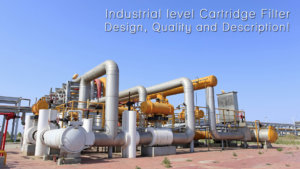
Cartridge filters refer to a simple piece of tubular filtration equipment which is designed for various industries for filtration requirements. The cartridge filters are most commonly used for filtration of water from all particles, chemicals, and other impurities. The cartridge filters are used to purify liquids, solvents, and water; it is designed to remove submicron particulates up to the size of 0.1 to 500 micron. The cartridge filters are known to be made commonly from polypropylene, also could be made from spun polyester and are mostly placed inside a tank for purification purposes. These systems work by pushing water through the system in which the water passes through the polyester filters and dirt gets collected on the screen allowing for clean water to pass by.
Sand filter vs Cartridge filter
Sand filters are known to be the oldest form of filtration system utilized for water clarification compared to cartridge filters. The common fact built on efficiency and qualification is that cartridge filters are better at screening out twice as much dirt and waste as a sand filter. The larger filtration area allows the water to progress through the cartridge and extract smaller particles of dirt. A sand filter is known to be facilitative to remove up to 20 microns, but the cartridge filters are known to be designed by industrialists to extract dirt particles up to the size of 10 microns. The maintenance cost associated with cartridge filters is accounted for less than what the sand filters are known to be. The cleaning process for cartridge filters is less complex which takes hardly 10 minutes to be cleaned through a backwash whereas cleaning of a sand filter through backwash takes more than 2o minutes. Backwashing sand filters whilst takes a longer period it also involves the risk of some chemicals getting back in the cleared water. The mobility for cartridge filters is effortless, while winters or the periods of dis-functioning of filters anyone could easily move the filter from the working surrounding to storage, whereas the sand filters are known to be weighed approximately 100-250 lbs and hence mobility is restricted or at least difficult.
Types of cartridge filters
Largely cartridge filters are of two types namely; surface filters and depth filters.
- Surface filters: they facilitate in the extraction of solids/contaminants of wastes from the elements entering through the medium. The surface filtration system refers to the flow of fluid through to a layer of material that restricts particles to move through the surface. The size of the particles restricted by the surface to enter is normally higher than the mean pore size of the medium. The process of cleaning through surface filters the screen extracts dirt and collects until the very limit and then the requirement for cleaning the screen for reuse arises. Surface filters are economically cheaper and have a shorter shelf span, the mechanical strength when compared is less. For eg: cellulose filter, pleated cartridge filters.
- Depth filters: these filters hold every solid, pollutants and contaminant within the media itself. Depth filtration refers to a thick layer of media/multiple layers that sets an excruciating pathway for the particles and hamper them from passing through. The size of particles restricted by the depth filtration system is smaller than the mean pore size of the medium. Contaminants, dirt and solid pollutants get stuck on the screen and eventually builds a blockage and hence requires cleaning, through a reverse flow of fluid or replaced by a new medium. Though depth filters are supposedly expensive compared to surface filters they also provide with a longer shelf life, also the mechanical strength of filter medium is relatively high. For eg: string wound filter, ceramic filters, and sintered filters.
Utilization of cartridge filters
Cartridge filters while being the most versatile can be utilized in numerous forms like:
Liquid filtration:
- Bulk chemicals
- Petrochemicals
- Water purification
- Hydraulic fluids
- Cosmetics/pharmaceuticals
- Reagent grade chemicals
- Paints, varnishes
- Semiconductors
- Electric utilities
- Often used as final filtration after other filters.
- Dust removal in industrial atmospheres
- Compressed air filtering: smokes, fumes, solid contaminants in the system.
But, a more clarified form of applications list for cartridge filters is:
- Self-cleaning and pre-filtration to RO and other types of membranes
- Industrial water filtration
- Pool water filtration
- Oil removal and particle filtration in petrochemicals
- Liquid filtration in the food and beverage industry
- Pharmaceuticals
- Refineries and Petro-chemicals
- Inks, paints and specialty coatings
- Electroplating chemical filtration
- Cosmetics and personal care
- Wine clarification
- Brewing
- Automotive
